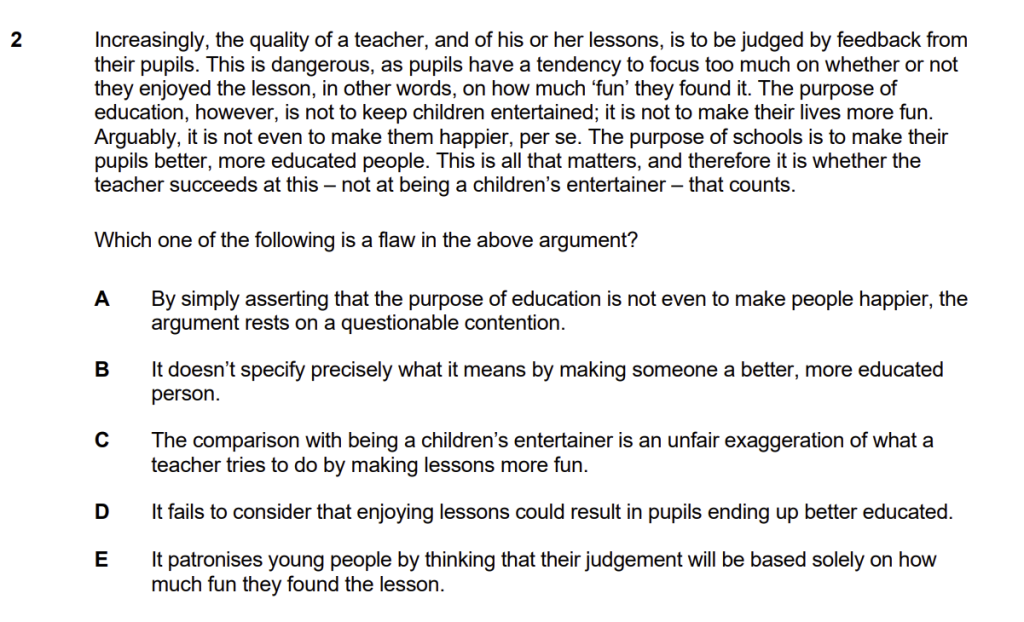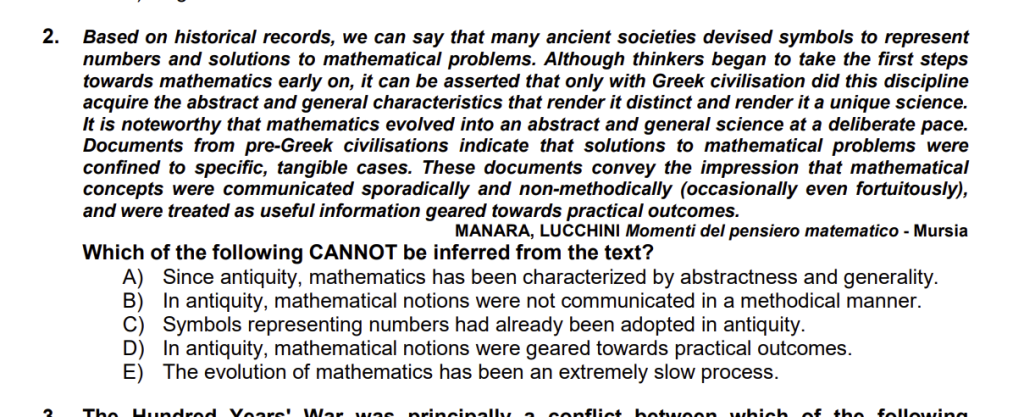
Ari Horesh University of Pavia, Italy
27th of December, 2024Hello everyone! Ari is here. I am writing this guide today after analyzing IMAT 2024 to ensure you understand that the new logic format of the IMAT is now completely different. Unlike many not-updated websites that still show the logic section as the old Cambridge-style 7 types of critical thinking and problem-solving questions, the new section and what we expect for IMAT 2026 will most likely be new.
Please read this article carefully, and note that I will post and compare some questions from IMAT 2024 so you can better understand what I am talking about.
Before I continue, I wanted to remind you that by navigating to the “entrance exam” menu button, you will see many more basic articles that cover, analyze, and give you crucial tips about all sections of the IMAT but also how to choose a university (and ‘enter med school’ properly, so I am attaching them down below, take a look after finishing this article:
Old vs. New IMAT Logic Section
From 2011 to 2022, Cambridge, the same organization that also used to write the TSA (thinking skills assessment) and BMAT (an exam similar to the IMAT), wrote and organized the IMAT exam. That meant they used their classic set of critical thinking and problem-solving questions, which mainly revolved around spatial recognition, probability, and statistics, as well as a very specific set of 7 types of critical thinking questions. However, since 2023, because Cambridge no longer writes the IMAT exam, the Italian Ministry of Education is organizing and writing it (through different companies, but last year it was them themselves that wrote and organized it)
Content Quick Navigation
The logic section of the last IMAT was even weirder and more different than IMAT 2023, so I decided to rewrite this article (which used to be about the old IMAT).

As you can see from the picture above, from IMAT 2019 (the one I took) the logic questions were a paragraph that they give you and then you had to find the flaws, argument, conclusion, etc. This is no longer the case, as the new IMAT logic section mainly revolves around English comprehension and grammar.

The question above is from the latest IMAT of 2024, as you can see, the question above doesn’t ask you about a specific skill, but it’s more of a general english comprehension questino that you see more in language exams and not on the past papers of the IMAT.

Another question above, where you can see they now also ask about grammar, confused many of my students. they thought there was some trick in the question, but it is just a simple English language grammar question, and honestly, it’s pretty much free points on the exam.
You can also notice that the new logic section is divided into two sections:
- “Reading skills and knowledge acquired during studies” – where they discussed exactly what I mentioned above. Instead of the classic critical thinking questions similar to what Cambridge did, it’s just English language test questions together with some general knowledge questions
- “Logical reasoning and problem-solving” – this one is supposed to look like the old IMAT “problem solving” section; in the past, when we had spatial recognition style questions, this one seemed to be heavy in probability and statistics questions.
How To Study For The New IMAT Logic Section?
As we could see before, we have two new sections to study that make up the entire logic section, “English comprehension and general knowledge” and “Logical reasoning and problem-solving” questions.
I recommend starting to study other sections and not the logic section, so the first early stage of logic would mainly be watching movies and reading English articles while adding more practice and studying.
English Comprehension and General Knowledge
- Solving past papers of the old IMAT, together with past papers of TSA and BMAT Section 1: although these sections won’t teach you the technique to approach this kind of questions, they will definetely allow you to practice your English and understand much better how to find the conclusions and essence of different paragraphs that you might be given in the exam.
- Read some more books, online medical articles, and literature; if you are not a native English speaker and need to improve your English, do it by reading as much as possible – things related to other topics of the IMAT exam. Watch YouTube videos with subtitles when you study to practice your English while studying something else.
- Work on your grammar: This one is pretty important! Work on your grammar skills by buying simple local books (maybe books they teach you in high school), and make sure your grammar level is high enough.
Logical Reasoning and Problem-Solving
To study for the harder “Logical reasoning and problem-solving,” I recommend not neglecting math, probability, and statistics, which seem to repeat too many times in both the logic and the math sections of the IMAT – to the point that if you don’t know them, it will cost you a lot of points on the exam itself. Make sure you study math well for the upcoming exam.
The questions above are classic probability and statistics questions and basic problem-solving questions. To properly study for those sections, here is a list based on IMAT 2024 of what exactly they asked (I analyzed all questions). I will give you the proper technical terms so you can take them and look up similar exercises and practice.
A notable observation I made while testing my students is how much less time it took them to solve any question in the logic section of the IMAT. In the past, some questions took even 3.5-5 minutes to solve, while today, most questions, on average, were solved by my students in around 30 seconds to 2 minutes. Considering how easy the biology and chemistry sections were, it gave students plenty of time to solve the harder questions of the IMAT exam.
Reading and Interpreting a Frequency Table

understand how to read a table that lists different values, how to sum to find and average the total numbers, convert fractions to percentages, and vice versa. Some topics asked in the first question that could appear on IMAT 2026 are frequency distribution, data interpretation, absolute vs. relative frequency, and percentage calculation.
Basic Probability & Ratio Reasoning

In this question, you needed to compute the probability that someone receives a gold-plated pen when silver-plated pens are twice as numerous. So, to solve it, you need to know how to set the variables and use a simple equation to solve it, then find the percentages and proportions out of the total (and break them into categories), then use simple probability fractions to understand what factions they were from the total. Some topics that appeared in that question were basic probability, ratio/proportion, variable assignment, and percentage decomposition.
Successive (Consecutive) Percentage Changes

This is a classic question that shows whether you know how to make consecutive percentage changes. For example, when you have something discounted at the store, they tell you you get another discount on top of that new price. To do that, you need to understand that it’s not a simple addition of percentages but something that is part of the IMAT syllabus and called “multiplicative.” You need to apply the discount and the second one on the new price you got from the previous one. Here are some skills you need to have to solve that question: sequential discounts, multiplicative changes (as opposed to additive), and net percentage change.
3D Geometry & Counting Surface Blocks

This question requires basic spatial recognition and math and geometry skills. To solve this question, you must understand that a cube is a number to the power 3. Because you don’t have a calculator, you must take some numbers and try to reach 343 by cubing them. Students who practice math and geometry would have known quickly that it’s 7. We could count how many cubes we have inside if we exclude the outer layer and quickly reach the answer. Still, you must have the following skills: three-dimensional geometry, surface-layer blocks, interior vs. exterior, complementary counting, and spatial reasoning.
Logical Reasoning with Conditionals

I love this type of question. Many students try to solve them using gut feeling, but there are a few really simple methods to approach them that you should be familiar with for the next IMAT, as I suspect it will most likely stay about the same in terms of what they ask in this section.
Interpreting a statement of the form “If P, then Q” (in logic notation, P ⟹ Q) and identifying valid/invalid conclusions.
Implication (If–Then Statement): “When he takes the train (P), Marco always arrives on time (Q).”
Contrapositive: A logically equivalent re-statement is “If Marco did not arrive on time, then he did not take the train.”
Common Logical Fallacies: Mistaking Q implies P or concluding “If he arrived late, that means he took the train” is a fallacy. Students need to identify only what truly follows from the statement.
Key Terms to Emphasize when studying logic for the next exam:
- Implication (P => Q)
This reads, “If P, then Q.” Example: “If it rains (P), then the ground gets wet (Q).” - Contrapositive (not Q => not P)
The contrapositive is logically equivalent to the original implication. Example: “If the ground is not wet (not Q), then it did not rain (not P).” - Modus ponens
If (P => Q) is true and P is true, then Q must be true. - Modus tollens
If (P => Q) is true and Q is false, then P must be false. - Logical fallacy
An invalid form of argument that does not follow logically from the premises.
Key Points
To summarize everything we discussed today, I want to say again that the IMAT logic section is no longer what it used to be. A proper way of looking at it would be considering it a brand new section added to the IMAT, as we never really had this type of question asked on past papers, and it seemed to be a pattern that will most likely repeat. Using this article and understanding which topics they asked (I am sure you didn’t know many of the terms and topics I mentioned by name today, this will allow you to research those specific subjects and find resources and books explaining them, as well looking for those subjects within the books you are currently using to study) will allow you to be well prepared and updated. Ensure you don’t listen to misinformation websites that still use the old logic format and don’t bother to update their articles; it’s extremely misleading and can lead to students taking the IMAT expecting one type of question but getting a completely different type on the exam day itself.





